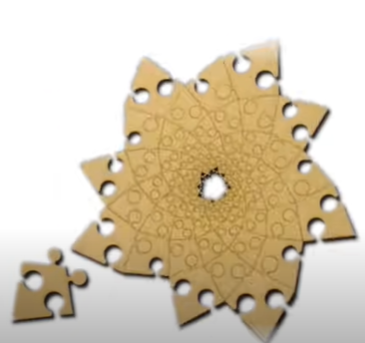The Big, Complicated Process of John Edmark’s Intriguing and Beautiful Bloom Spirals

Chromotaxis by John Edmark
John Edmark is an engineer who experiments with angles and spirals to create patterns. Edmark makes his work to look for unusual behaviors in math and art.
The Math
The math in Edmark’s pieces is not necessarily complex. A simple explanation of this is to use flower petals. So, say you have a flat circle and you put one petal on any place on the edge of the circle, then you would go either to the left or the right 137.5 degrees, keep doing that until you think it is enough. Using 137.5 degrees (or the Golden Angle) is one way Edmark makes his spirals. He also uses something called the Fibonacci series, which is a group of numbers where the rule is to get the next number in the series by adding the previous two numbers. An example of the Fibonacci series in real life is a pineapple, where there are little square grids shown in a curved pattern on a round surface.
The Patterns
The pattern-ing of the spirals is very related to the math. By using the Golden Angle (137.5 degrees), Edmark knows where to put the next piece of texture in his bloom. Edmark also uses a pattern-ing tactic called Chromotaxis. Chromotaxis is using the Fibonacci Series to create spirals, or the Fibonacci Series put into a spiral, like the flat version of the pattern on a Pineapple. Or in short, Fibonacci Tiling. Edmark was even able to make a puzzle using the Fibonacci Tiling where all the pieces were the same shape but not one of them the same size.
Edmark’s Projects
Picking up from the puzzle, Edmark was able to make a puzzle in the shape of Chromotaxis using the Fibonacci Tiling where all the pieces were the same shape but different sizes. Even cooler is having two of the same puzzle (just focusing on the outline), then adding a piece on the puzzle to the right, rotating that puzzle -137.5 degrees, the outline of both puzzles perfectly align.
Another project of Edmark’s is Transtower, which by using that puzzle outline, can be rotated to create step-like plateaus on the sides, and by rotating it forever in one direction, you can get a lot of cool patterns. The Transtower works by a discovery from Paul Dancstep, Edmark’s partner and a worker at the Exploratorium in San Francisco, California. Dancstep’s discovery came out of a microwave one night when he noticed a crack in the glass dish that perfectly aligned with a wheel on the Lazy Susan. When the crack made two full rotations, it perfectly lined up with the same wheel. So, Dancstep conducted an experiment. By rotating the dish 90 degrees, the wheel is at 45 degrees, dividing it equally by two. Then by adding another Lazy Susan and rotating, the two wheels between the crack and the starting point are equally distributed. Then by adding ANOTHER Lazy Susan, the wheels will still distribute themselves evenly between the crack and the starting point, and so on as you keep on adding Lazy Susans. By using this microwave mechanism, Dancstep and Edmark were able to make Transtower properly behave with gears to make pattern after pattern.
The Blooms
Making the actual blooms is a complicated process. In Paul Dancstep’s video, The Art of John Edmark, he explains the process Edmark uses to figure out the animation of a certain bloom. So, say you have a certain repeating gif, then you take the same gif and put it next to the original gif, and put the offset by half, then you do that about six more times, then it creates a looped animation called a Zoetrope. Then, by using the Fibonacci Tiling, imagining that each square grid is a tiny frame, rotating the Fibonacci 137.5 degrees and strobing it, then doing it over and over, you would get a cool Zoetrope. When you play it, it looks like each frame is slowly growing as it comes out of the center. That is how Edmark makes his blooms. By using the Golden Angle, Fibonacci Series, Chromotaxis, and Zoetrope, Edmark knows where to put each texture or petal on the bloom. First, Edmark designs the structure using a computer. Then, he shapes each individual element. Once he’s done with that, he strobes it, and then you have a bloom.
What Edmark is trying to achieve in his work is to inspire and to interest people in his work so that they would also want to create stuff too.










